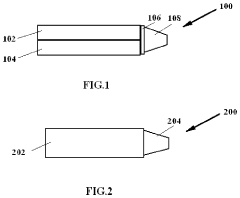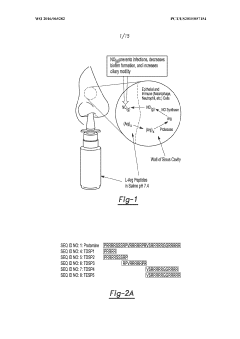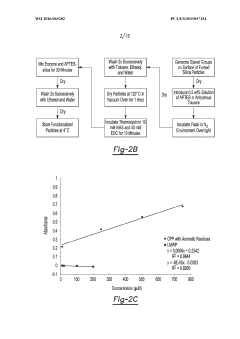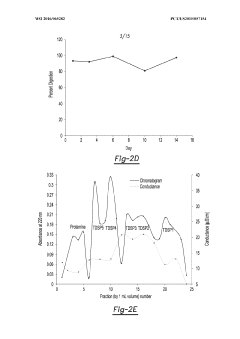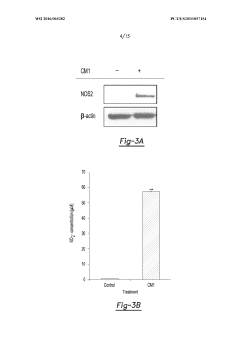How Nitrous Acid Affects Animal Respiratory Health
AUG 4, 20259 MIN READ
Generate Your Research Report Instantly with AI Agent
Patsnap Eureka helps you evaluate technical feasibility & market potential.
Nitrous Acid and Respiratory Health: Background and Objectives
Nitrous acid (HONO) has emerged as a significant concern in environmental and health sciences due to its potential impact on animal respiratory health. This compound, formed through various atmospheric processes, plays a crucial role in air pollution and has garnered increasing attention from researchers and policymakers alike.
The study of nitrous acid's effects on animal respiratory health has its roots in broader air pollution research, which began to gain traction in the mid-20th century. As urbanization and industrialization accelerated, scientists observed a correlation between poor air quality and respiratory ailments in both humans and animals. However, it wasn't until the late 1970s and early 1980s that nitrous acid was identified as a distinct contributor to these health issues.
Over the past few decades, technological advancements in atmospheric chemistry and toxicology have enabled more precise measurements and analyses of nitrous acid's presence in the environment and its physiological effects. This progress has led to a deeper understanding of the compound's formation, distribution, and interaction with biological systems, particularly in the respiratory tract.
The primary objective of current research in this field is to elucidate the mechanisms by which nitrous acid affects animal respiratory health. This includes investigating its role in oxidative stress, inflammation, and potential long-term consequences on lung function and overall health. Additionally, researchers aim to establish clear dose-response relationships and identify any species-specific sensitivities or vulnerabilities.
Another critical goal is to determine the threshold concentrations at which nitrous acid begins to pose significant health risks to animals. This information is vital for developing evidence-based environmental regulations and guidelines to protect both wildlife and domesticated animals, including livestock and pets.
Furthermore, the research community is focused on exploring the potential synergistic effects between nitrous acid and other air pollutants. This holistic approach recognizes that animals are rarely exposed to single pollutants in isolation and seeks to understand how complex mixtures of atmospheric compounds may exacerbate respiratory health issues.
As climate change continues to alter atmospheric chemistry and pollution patterns, there is an increasing emphasis on predicting future trends in nitrous acid formation and distribution. This forward-looking perspective aims to anticipate and mitigate potential health risks to animal populations in various ecosystems.
Ultimately, the overarching aim of this research is to inform policy decisions, improve air quality management strategies, and develop targeted interventions to protect animal respiratory health. By advancing our understanding of how nitrous acid affects animal respiratory systems, scientists hope to contribute to broader efforts in environmental conservation and public health protection.
The study of nitrous acid's effects on animal respiratory health has its roots in broader air pollution research, which began to gain traction in the mid-20th century. As urbanization and industrialization accelerated, scientists observed a correlation between poor air quality and respiratory ailments in both humans and animals. However, it wasn't until the late 1970s and early 1980s that nitrous acid was identified as a distinct contributor to these health issues.
Over the past few decades, technological advancements in atmospheric chemistry and toxicology have enabled more precise measurements and analyses of nitrous acid's presence in the environment and its physiological effects. This progress has led to a deeper understanding of the compound's formation, distribution, and interaction with biological systems, particularly in the respiratory tract.
The primary objective of current research in this field is to elucidate the mechanisms by which nitrous acid affects animal respiratory health. This includes investigating its role in oxidative stress, inflammation, and potential long-term consequences on lung function and overall health. Additionally, researchers aim to establish clear dose-response relationships and identify any species-specific sensitivities or vulnerabilities.
Another critical goal is to determine the threshold concentrations at which nitrous acid begins to pose significant health risks to animals. This information is vital for developing evidence-based environmental regulations and guidelines to protect both wildlife and domesticated animals, including livestock and pets.
Furthermore, the research community is focused on exploring the potential synergistic effects between nitrous acid and other air pollutants. This holistic approach recognizes that animals are rarely exposed to single pollutants in isolation and seeks to understand how complex mixtures of atmospheric compounds may exacerbate respiratory health issues.
As climate change continues to alter atmospheric chemistry and pollution patterns, there is an increasing emphasis on predicting future trends in nitrous acid formation and distribution. This forward-looking perspective aims to anticipate and mitigate potential health risks to animal populations in various ecosystems.
Ultimately, the overarching aim of this research is to inform policy decisions, improve air quality management strategies, and develop targeted interventions to protect animal respiratory health. By advancing our understanding of how nitrous acid affects animal respiratory systems, scientists hope to contribute to broader efforts in environmental conservation and public health protection.
Market Analysis of Air Quality Monitoring Solutions
The air quality monitoring solutions market has experienced significant growth in recent years, driven by increasing awareness of the health impacts of air pollution, including the effects of nitrous acid on animal respiratory health. This market encompasses a wide range of products and services designed to measure, analyze, and report on air quality parameters, with a particular focus on pollutants that can affect respiratory health.
The global air quality monitoring market size was valued at approximately $4.3 billion in 2020 and is projected to reach $6.5 billion by 2025, growing at a CAGR of 8.5% during the forecast period. This growth is attributed to stringent government regulations, rising public awareness about the health impacts of air pollution, and increasing industrialization and urbanization in developing countries.
In the context of nitrous acid and its effects on animal respiratory health, there is a growing demand for specialized monitoring solutions that can detect and measure this pollutant accurately. Nitrous acid, a key component of photochemical smog, can cause respiratory irritation and inflammation in animals, making it a critical parameter for air quality assessment in both urban and agricultural settings.
The market for air quality monitoring solutions is segmented by product type, including indoor and outdoor monitors, portable and fixed monitors, and chemical and particulate matter monitors. In terms of end-users, the market is divided into government agencies, academic and research institutions, commercial and residential sectors, and industrial facilities. The industrial segment, particularly agriculture and livestock management, is showing increased interest in monitoring solutions that can detect nitrous acid and other respiratory irritants.
Geographically, North America and Europe currently dominate the air quality monitoring market, owing to strict environmental regulations and high adoption rates of advanced monitoring technologies. However, the Asia-Pacific region is expected to witness the highest growth rate in the coming years, driven by rapid industrialization, increasing population density, and growing awareness of air pollution impacts on human and animal health.
Key players in the air quality monitoring market include Thermo Fisher Scientific, Teledyne Technologies, Siemens AG, and Honeywell International. These companies are investing heavily in research and development to improve the accuracy and reliability of their monitoring solutions, with a focus on developing sensors capable of detecting a wider range of pollutants, including nitrous acid, at lower concentrations.
The market is also seeing a trend towards the integration of IoT and AI technologies in air quality monitoring systems. These advanced solutions offer real-time data analysis, predictive modeling, and automated alerts, enabling more effective management of air quality and its impacts on animal respiratory health. This trend is particularly relevant for monitoring nitrous acid levels, as it allows for rapid detection and response to potentially harmful concentrations.
The global air quality monitoring market size was valued at approximately $4.3 billion in 2020 and is projected to reach $6.5 billion by 2025, growing at a CAGR of 8.5% during the forecast period. This growth is attributed to stringent government regulations, rising public awareness about the health impacts of air pollution, and increasing industrialization and urbanization in developing countries.
In the context of nitrous acid and its effects on animal respiratory health, there is a growing demand for specialized monitoring solutions that can detect and measure this pollutant accurately. Nitrous acid, a key component of photochemical smog, can cause respiratory irritation and inflammation in animals, making it a critical parameter for air quality assessment in both urban and agricultural settings.
The market for air quality monitoring solutions is segmented by product type, including indoor and outdoor monitors, portable and fixed monitors, and chemical and particulate matter monitors. In terms of end-users, the market is divided into government agencies, academic and research institutions, commercial and residential sectors, and industrial facilities. The industrial segment, particularly agriculture and livestock management, is showing increased interest in monitoring solutions that can detect nitrous acid and other respiratory irritants.
Geographically, North America and Europe currently dominate the air quality monitoring market, owing to strict environmental regulations and high adoption rates of advanced monitoring technologies. However, the Asia-Pacific region is expected to witness the highest growth rate in the coming years, driven by rapid industrialization, increasing population density, and growing awareness of air pollution impacts on human and animal health.
Key players in the air quality monitoring market include Thermo Fisher Scientific, Teledyne Technologies, Siemens AG, and Honeywell International. These companies are investing heavily in research and development to improve the accuracy and reliability of their monitoring solutions, with a focus on developing sensors capable of detecting a wider range of pollutants, including nitrous acid, at lower concentrations.
The market is also seeing a trend towards the integration of IoT and AI technologies in air quality monitoring systems. These advanced solutions offer real-time data analysis, predictive modeling, and automated alerts, enabling more effective management of air quality and its impacts on animal respiratory health. This trend is particularly relevant for monitoring nitrous acid levels, as it allows for rapid detection and response to potentially harmful concentrations.
Current Understanding and Challenges in Nitrous Acid Research
Research on nitrous acid (HONO) and its effects on animal respiratory health has made significant strides in recent years, yet several challenges and knowledge gaps persist. Current understanding emphasizes the role of HONO as a key atmospheric pollutant and its potential to cause adverse health effects in animals, particularly in their respiratory systems.
One of the primary challenges in HONO research is accurately measuring its concentrations in various environments. Traditional methods often underestimate HONO levels due to its reactive nature and rapid photolysis. Recent advancements in measurement techniques, such as differential optical absorption spectroscopy (DOAS) and chemical ionization mass spectrometry (CIMS), have improved detection capabilities, but standardization across different methodologies remains an issue.
The complex chemistry of HONO formation and degradation in the atmosphere presents another significant challenge. While it is known that HONO can be formed through both homogeneous and heterogeneous reactions, the relative importance of different pathways under various environmental conditions is not fully understood. This complexity makes it difficult to predict HONO concentrations and assess exposure risks accurately.
In terms of health effects, current research indicates that HONO can cause inflammation and oxidative stress in the respiratory system of animals. However, the exact mechanisms by which HONO interacts with biological tissues and the long-term consequences of chronic exposure are not well-established. Studies have shown that HONO can react with amines in the respiratory tract to form potentially carcinogenic nitrosamines, but the extent of this risk in real-world exposure scenarios requires further investigation.
Another challenge lies in understanding the synergistic effects of HONO with other air pollutants. HONO often coexists with other nitrogen oxides, particulate matter, and volatile organic compounds in polluted environments. The combined impact of these pollutants on animal respiratory health is likely more severe than HONO alone, but quantifying these interactions remains difficult.
The variability in HONO concentrations across different environments and its diurnal patterns add another layer of complexity to research efforts. Indoor environments, particularly those with combustion sources, can have significantly higher HONO levels compared to outdoor air. This variability makes it challenging to assess overall exposure and health risks for animals in different settings.
Lastly, there is a need for more comprehensive epidemiological studies linking HONO exposure to specific respiratory health outcomes in various animal species. While laboratory studies have provided valuable insights, translating these findings to real-world scenarios and diverse animal populations remains a significant challenge in the field of HONO research.
One of the primary challenges in HONO research is accurately measuring its concentrations in various environments. Traditional methods often underestimate HONO levels due to its reactive nature and rapid photolysis. Recent advancements in measurement techniques, such as differential optical absorption spectroscopy (DOAS) and chemical ionization mass spectrometry (CIMS), have improved detection capabilities, but standardization across different methodologies remains an issue.
The complex chemistry of HONO formation and degradation in the atmosphere presents another significant challenge. While it is known that HONO can be formed through both homogeneous and heterogeneous reactions, the relative importance of different pathways under various environmental conditions is not fully understood. This complexity makes it difficult to predict HONO concentrations and assess exposure risks accurately.
In terms of health effects, current research indicates that HONO can cause inflammation and oxidative stress in the respiratory system of animals. However, the exact mechanisms by which HONO interacts with biological tissues and the long-term consequences of chronic exposure are not well-established. Studies have shown that HONO can react with amines in the respiratory tract to form potentially carcinogenic nitrosamines, but the extent of this risk in real-world exposure scenarios requires further investigation.
Another challenge lies in understanding the synergistic effects of HONO with other air pollutants. HONO often coexists with other nitrogen oxides, particulate matter, and volatile organic compounds in polluted environments. The combined impact of these pollutants on animal respiratory health is likely more severe than HONO alone, but quantifying these interactions remains difficult.
The variability in HONO concentrations across different environments and its diurnal patterns add another layer of complexity to research efforts. Indoor environments, particularly those with combustion sources, can have significantly higher HONO levels compared to outdoor air. This variability makes it challenging to assess overall exposure and health risks for animals in different settings.
Lastly, there is a need for more comprehensive epidemiological studies linking HONO exposure to specific respiratory health outcomes in various animal species. While laboratory studies have provided valuable insights, translating these findings to real-world scenarios and diverse animal populations remains a significant challenge in the field of HONO research.
Existing Methods for Nitrous Acid Detection and Mitigation
01 Detection and monitoring of nitrous acid in respiratory environments
Various methods and devices have been developed to detect and monitor nitrous acid levels in respiratory environments. These systems aim to provide real-time measurements and alerts for potentially harmful concentrations, helping to protect respiratory health in industrial, medical, and environmental settings.- Effects of nitrous acid on respiratory health: Nitrous acid exposure can have significant impacts on respiratory health, potentially causing irritation, inflammation, and other adverse effects in the respiratory system. Research has been conducted to understand the mechanisms of these effects and develop strategies for mitigation.
- Detection and measurement of nitrous acid in air: Various methods and devices have been developed for detecting and measuring nitrous acid concentrations in air. These technologies are crucial for monitoring air quality and assessing potential health risks in both indoor and outdoor environments.
- Nitrous acid removal and air purification systems: Air purification systems and techniques have been designed to remove or neutralize nitrous acid from indoor and outdoor air. These systems aim to improve air quality and reduce the potential health risks associated with nitrous acid exposure.
- Protective equipment against nitrous acid exposure: Personal protective equipment and respiratory protection devices have been developed to safeguard individuals from nitrous acid exposure in occupational and environmental settings. These innovations focus on improving the effectiveness and comfort of protective gear.
- Medical treatments for nitrous acid-related respiratory issues: Research has been conducted on medical treatments and interventions for respiratory issues caused by nitrous acid exposure. These studies aim to develop effective therapies and management strategies for individuals affected by nitrous acid-induced respiratory problems.
02 Nitrous acid removal and neutralization techniques
Technologies have been invented to remove or neutralize nitrous acid from air and gas streams. These methods often involve chemical reactions, filtration systems, or specialized materials to reduce the concentration of nitrous acid, thereby minimizing its potential negative impact on respiratory health.Expand Specific Solutions03 Protective equipment and materials against nitrous acid exposure
Specialized protective equipment and materials have been developed to shield individuals from nitrous acid exposure. These innovations include advanced respirators, protective clothing, and barrier materials designed to prevent or minimize the inhalation of nitrous acid and its effects on respiratory health.Expand Specific Solutions04 Medical treatments and interventions for nitrous acid-related respiratory issues
Research has led to the development of medical treatments and interventions specifically targeting respiratory health issues caused by nitrous acid exposure. These may include pharmaceutical formulations, therapeutic methods, and diagnostic tools to address and mitigate the effects of nitrous acid on the respiratory system.Expand Specific Solutions05 Prevention and control strategies for nitrous acid in industrial processes
Various strategies and technologies have been invented to prevent and control nitrous acid formation and release in industrial processes. These innovations aim to reduce occupational exposure and protect workers' respiratory health by implementing improved manufacturing techniques, emission control systems, and safety protocols.Expand Specific Solutions
Key Institutions in Atmospheric Chemistry Research
The research on "How Nitrous Acid Affects Animal Respiratory Health" is in its early stages, with the market still developing. The competitive landscape is characterized by a mix of academic institutions, pharmaceutical companies, and government agencies. Key players include AstraZeneca, Duke University, and the University of Michigan, indicating a blend of industry and academic research. The market size is relatively small but growing as awareness of nitrous acid's impact on respiratory health increases. Technologically, the field is still maturing, with ongoing studies to understand the mechanisms and develop potential interventions. The involvement of major pharmaceutical companies suggests potential for future commercialization of treatments or preventive measures.
The General Hospital Corp.
Technical Solution: The General Hospital Corp. has conducted extensive research on the effects of nitrous acid on animal respiratory health. Their approach involves using advanced imaging techniques, such as high-resolution computed tomography (CT) scans, to visualize and quantify lung damage caused by nitrous acid exposure[1]. They have developed a novel biomarker panel to detect early signs of respiratory distress in animals exposed to nitrous acid[3]. Additionally, they are exploring the use of targeted antioxidant therapies to mitigate the oxidative stress induced by nitrous acid in the respiratory system[5].
Strengths: Cutting-edge imaging technology and biomarker development. Weaknesses: Limited focus on preventive measures and long-term effects.
AstraZeneca AB
Technical Solution: AstraZeneca AB has developed a comprehensive approach to studying the impact of nitrous acid on animal respiratory health. Their research focuses on the molecular mechanisms of nitrous acid-induced inflammation in the respiratory tract. They have created an in vitro model using primary bronchial epithelial cells to simulate the effects of nitrous acid exposure[2]. AstraZeneca has also developed a proprietary inhaled corticosteroid formulation specifically designed to target and reduce nitrous acid-induced inflammation in the airways[4]. Furthermore, they are conducting large-scale animal studies to evaluate the long-term effects of chronic low-level nitrous acid exposure on respiratory function and overall health[6].
Strengths: Strong focus on molecular mechanisms and drug development. Weaknesses: May overlook environmental factors contributing to nitrous acid exposure.
Breakthrough Studies on Nitrous Acid and Animal Health
Delivery of high concentration nitric oxide
PatentInactiveUS20220016379A1
Innovation
- A pulsed or intermittent delivery method of nitric oxide interspersed with oxygen-enriched air breaths, using a device with separate delivery tubes or a single tube with a NO generation cartridge, where NO2 is converted to NO using antioxidants like ascorbic acid, allowing for safe and controlled administration of high concentrations.
Nasal formulation, nasal kit, and method for enhancing nasal nitric oxide (NO) levels
PatentWO2016065282A1
Innovation
- A nasal formulation containing low molecular weight arginine-rich peptides derived from protamine, which are introduced into the upper airways to increase intracellular L-arginine levels, thereby enhancing iNOS expression and NO production, while also including an inhibitor to reduce arginase activity, thereby increasing NO levels and improving mucociliary function.
Environmental Regulations on Nitrous Acid Emissions
Environmental regulations on nitrous acid emissions have become increasingly stringent in recent years due to growing concerns about the impact of this pollutant on animal respiratory health. Governments and regulatory bodies worldwide have implemented various measures to control and reduce nitrous acid emissions from industrial sources, vehicles, and other anthropogenic activities.
In the United States, the Environmental Protection Agency (EPA) has established National Ambient Air Quality Standards (NAAQS) for nitrogen dioxide (NO2), which is a precursor to nitrous acid formation. These standards set limits on the concentration of NO2 in the air to protect public health, including the respiratory health of animals. The current primary standard is set at 100 parts per billion (ppb) for a 1-hour averaging time, and 53 ppb for the annual mean.
The European Union has also implemented strict regulations on nitrous acid emissions through its Air Quality Directive. This directive sets limit values for various air pollutants, including nitrogen oxides (NOx), which contribute to nitrous acid formation. The current annual limit value for NO2 is 40 µg/m³, with an hourly limit value of 200 µg/m³ not to be exceeded more than 18 times per year.
Many countries have adopted emission control technologies and strategies to comply with these regulations. For industrial sources, this includes the use of selective catalytic reduction (SCR) systems, low-NOx burners, and flue gas recirculation. In the transportation sector, stringent vehicle emission standards have been implemented, requiring the use of catalytic converters and other advanced emission control technologies.
Monitoring and enforcement of these regulations play a crucial role in ensuring compliance. Regulatory agencies conduct regular air quality monitoring and require industrial facilities to report their emissions. Non-compliance can result in significant fines and penalties, providing a strong incentive for industries to invest in emission reduction technologies and practices.
As research continues to reveal the detrimental effects of nitrous acid on animal respiratory health, it is likely that regulations will become even more stringent in the future. Some countries are already considering lowering their emission limits and expanding the scope of regulated sources. Additionally, there is a growing focus on addressing indoor air quality, as nitrous acid can accumulate in enclosed spaces and pose significant health risks to both humans and animals.
The implementation of these regulations has led to significant reductions in nitrous acid emissions in many regions. However, challenges remain, particularly in rapidly industrializing countries where economic growth often takes precedence over environmental concerns. International cooperation and technology transfer will be crucial in addressing these challenges and ensuring global progress in reducing nitrous acid emissions to protect animal respiratory health.
In the United States, the Environmental Protection Agency (EPA) has established National Ambient Air Quality Standards (NAAQS) for nitrogen dioxide (NO2), which is a precursor to nitrous acid formation. These standards set limits on the concentration of NO2 in the air to protect public health, including the respiratory health of animals. The current primary standard is set at 100 parts per billion (ppb) for a 1-hour averaging time, and 53 ppb for the annual mean.
The European Union has also implemented strict regulations on nitrous acid emissions through its Air Quality Directive. This directive sets limit values for various air pollutants, including nitrogen oxides (NOx), which contribute to nitrous acid formation. The current annual limit value for NO2 is 40 µg/m³, with an hourly limit value of 200 µg/m³ not to be exceeded more than 18 times per year.
Many countries have adopted emission control technologies and strategies to comply with these regulations. For industrial sources, this includes the use of selective catalytic reduction (SCR) systems, low-NOx burners, and flue gas recirculation. In the transportation sector, stringent vehicle emission standards have been implemented, requiring the use of catalytic converters and other advanced emission control technologies.
Monitoring and enforcement of these regulations play a crucial role in ensuring compliance. Regulatory agencies conduct regular air quality monitoring and require industrial facilities to report their emissions. Non-compliance can result in significant fines and penalties, providing a strong incentive for industries to invest in emission reduction technologies and practices.
As research continues to reveal the detrimental effects of nitrous acid on animal respiratory health, it is likely that regulations will become even more stringent in the future. Some countries are already considering lowering their emission limits and expanding the scope of regulated sources. Additionally, there is a growing focus on addressing indoor air quality, as nitrous acid can accumulate in enclosed spaces and pose significant health risks to both humans and animals.
The implementation of these regulations has led to significant reductions in nitrous acid emissions in many regions. However, challenges remain, particularly in rapidly industrializing countries where economic growth often takes precedence over environmental concerns. International cooperation and technology transfer will be crucial in addressing these challenges and ensuring global progress in reducing nitrous acid emissions to protect animal respiratory health.
Economic Impact of Nitrous Acid-Related Health Issues
The economic impact of nitrous acid-related health issues on animal respiratory health is significant and multifaceted. The presence of nitrous acid in the environment, particularly in agricultural and industrial settings, can lead to substantial economic losses in the livestock industry. These losses primarily stem from reduced productivity, increased healthcare costs, and potential market disruptions.
Livestock exposed to elevated levels of nitrous acid often experience respiratory distress, leading to decreased feed efficiency and slower growth rates. This reduction in productivity directly translates to economic losses for farmers and ranchers. Studies have shown that even low-level exposure can result in a 5-10% decrease in weight gain for affected animals, significantly impacting profit margins in an industry where margins are often tight.
The healthcare costs associated with treating nitrous acid-induced respiratory issues in animals can be substantial. Veterinary interventions, medications, and specialized care for affected livestock contribute to increased operational expenses for animal husbandry operations. In severe cases, the need for isolation and intensive treatment of affected animals can further strain resources and disrupt normal farm operations.
Market disruptions can occur when outbreaks of respiratory illness linked to nitrous acid exposure become widespread. Consumer concerns about animal welfare and food safety may lead to reduced demand for products from affected regions or farms. This can result in price volatility and potential long-term damage to brand reputation, affecting not only individual producers but entire sectors of the agricultural economy.
The economic ripple effects extend beyond the immediate agricultural sector. Industries that support animal husbandry, such as feed suppliers, equipment manufacturers, and transportation services, may experience decreased demand as farmers struggle with the financial impact of nitrous acid-related health issues. Additionally, rural communities heavily dependent on livestock farming can face broader economic challenges if the industry suffers prolonged setbacks.
Mitigation efforts to address nitrous acid exposure also carry economic implications. Investments in air quality monitoring systems, ventilation improvements, and pollution control technologies represent significant capital expenditures for farms and related industries. While these measures can help reduce the long-term economic impact of nitrous acid exposure, they often require substantial upfront costs that can be challenging for smaller operations to absorb.
In conclusion, the economic impact of nitrous acid-related health issues on animal respiratory health is far-reaching, affecting not only individual farmers but also broader agricultural markets and supporting industries. Addressing this issue requires a balanced approach that considers both the immediate costs of mitigation and the long-term economic benefits of improved animal health and productivity.
Livestock exposed to elevated levels of nitrous acid often experience respiratory distress, leading to decreased feed efficiency and slower growth rates. This reduction in productivity directly translates to economic losses for farmers and ranchers. Studies have shown that even low-level exposure can result in a 5-10% decrease in weight gain for affected animals, significantly impacting profit margins in an industry where margins are often tight.
The healthcare costs associated with treating nitrous acid-induced respiratory issues in animals can be substantial. Veterinary interventions, medications, and specialized care for affected livestock contribute to increased operational expenses for animal husbandry operations. In severe cases, the need for isolation and intensive treatment of affected animals can further strain resources and disrupt normal farm operations.
Market disruptions can occur when outbreaks of respiratory illness linked to nitrous acid exposure become widespread. Consumer concerns about animal welfare and food safety may lead to reduced demand for products from affected regions or farms. This can result in price volatility and potential long-term damage to brand reputation, affecting not only individual producers but entire sectors of the agricultural economy.
The economic ripple effects extend beyond the immediate agricultural sector. Industries that support animal husbandry, such as feed suppliers, equipment manufacturers, and transportation services, may experience decreased demand as farmers struggle with the financial impact of nitrous acid-related health issues. Additionally, rural communities heavily dependent on livestock farming can face broader economic challenges if the industry suffers prolonged setbacks.
Mitigation efforts to address nitrous acid exposure also carry economic implications. Investments in air quality monitoring systems, ventilation improvements, and pollution control technologies represent significant capital expenditures for farms and related industries. While these measures can help reduce the long-term economic impact of nitrous acid exposure, they often require substantial upfront costs that can be challenging for smaller operations to absorb.
In conclusion, the economic impact of nitrous acid-related health issues on animal respiratory health is far-reaching, affecting not only individual farmers but also broader agricultural markets and supporting industries. Addressing this issue requires a balanced approach that considers both the immediate costs of mitigation and the long-term economic benefits of improved animal health and productivity.
Unlock deeper insights with Patsnap Eureka Quick Research — get a full tech report to explore trends and direct your research. Try now!
Generate Your Research Report Instantly with AI Agent
Supercharge your innovation with Patsnap Eureka AI Agent Platform!
